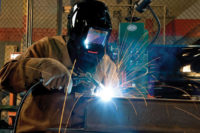Arc eye, or welder’s flash, is an inflammation of the cornea, caused by the UV rays from the arc during welding. The symptoms, which appear a few hours to several hours after exposure, can include mild to severe pain, red watery eyes, sensitivity to light and the feeling of a foreign object in the eye. Typically, arc eye is temporary, but repeated or prolonged exposure can lead to permanent eye injury.
UV radiation can also affect exposed skin, causing “sunburn,” similar to the sunburns associated with overexposure to the sun’s UV rays. Longer exposure without protection can lead to second- and even third-degree burns.
Most burns are avoidable if welders take the required precautions.
Your eyes
Precautions require personal protective equipment (PPE). Key protections are called for in OSHA Standards 29 CFR Part 1910. Standard 1910.252 is the welding, cutting and brazing standard. This standard’s section (b)(2) specifies the eye protection that is required, such as helmets, goggles and face shields.
Also, OSHA 29 CFR 1910.133 states the requirements for eye and face protection. The standard refers to a specific filter lens protection for various types of welding in 1910.133(a)(5) and also states welder lenses must comply with the ANSI Z87.1 standard, the American National Standard for Occupational and Educational Personal Eye and Face Protection Devices.
The welding helmet is probably the most important piece of PPE a welder uses. The proper helmet has a viewing area that provides UV ray protection and covers the entire face to protect from sparks and spatter.
A welding helmet must have filter lenses with a shade number that provides the appropriate level of protection. The lens shade number (10 being brighter, 13 being darker) indicates the intensity of light radiation that is allowed to pass through a filter lens to the eyes. Therefore, the higher the shade number, the darker the filter and the less light radiation that passes through the lens.
The lens shade number only denotes the amount of darkness provided by that particular lens and does not correspond to the amount of protection that is provided to the eyes. All quality welding lenses filter out 100 percent of the harmful UV and infrared (IR) rays to protect the eyes.
The best protection from flash is an auto-darkening helmet, whether fixed or with variable controls, that operates through a series of two to four sensors. When a flash occurs, the auto-darkening helmet adapts to the brightness of the flash and darkens to almost any pre-selected shade number in milliseconds.
With auto-darkening helmets, welders can see clearly while the hood is already in a down position, so that setting up to weld can be done with the hood in position.
Your thin skin
Welders must also protect their skin. OSHA 29 CFR 1910.252 (b)(3) and 29 CFR 1910.132, the general OSHA PPE standard, address the correct PPE to prevent burning exposed skin.
Heavy, flame-resistant gloves should always be worn to protect hands and wrists from UV radiation and spatter and sparks emitted while welding. After welding, gloves should be kept on until the welder is done handling any hot metal parts and equipment in the workstation. There is a huge selection of material types (typically leather) and thicknesses for welding gloves.
Welding clothing is intended to protect the welder from sparks and spatter and high heat. For welding clothing, avoid synthetic fabrics because any sparks that land will catch fire and burn skin quickly. Because of its durability and resistance to fire, wool clothing is suggested over synthetics. Likewise, cotton clothing is another option.
Welding sleeves protect the welder’s arms from the armpit to the wrist and often can be connected to welding gloves. These provide adequate protection in low-volume welding. Welding sleeve fabric should be flame-resistant cotton, leather or Kevlar knit.
Heavy-duty leather boots with a high ankle keep feet safe. Pants should be left outside work boots, not tucked in, to keep sparks from falling into the boots. Shoe lace guards are even available for protection from sparks.
Welding hats or caps that cover the head, ears and neck also offer protection from high heat and sparks. Sparks falling into the ear canal is always a distinct possibility, especially when a welder is working at an odd angle. Flame-resistant earplugs are an option for this situation. In addition to protecting a welder from burns in and near the ear, they also provide noise protection from grinders and other equipment.
Source: Weld



